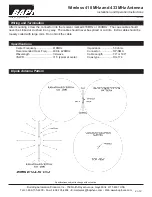
18709_ins_418_433_antenna
Wireless 418 MHz and 433 MHz Antenna
Building Automation Products, Inc., 750 North Royal Avenue, Gays Mills, WI 54631 USA
Tel:+1-608-735-4800 • Fax+1-608-735-4804 • E-mail:sales@bapihvac.com • Web:www.bapihvac.com
1 of 2
Specifications subject to change without notice.
Installation and Operation Instructions
rev. 01/20/14
Overview and Identification
Mounting
The BAPI 418 MHz or 433 MHz dipole antenna (BA/ANT418 or BA/ANT433) features a durable, unobtrusive
housing that sticks permanently with integral adhesive to flat, non-conductive surfaces such as windows,
drywall, ceiling tiles, plastic, etc.
The cable comes in a standard 79” length or optional 180” length and a screw-on RP-SMA coax connector.
The antenna has flexible dipole shafts and offers a horizontal Omni directional pattern when shafts are
mounted vertically with a minimal sensitivity vertically.
Fig. 1:
418/433 MHz Receiver and Dipole Antenna
Fig. 2:
418/433 MHz Dipole Antenna
To mount the 418 MHz or 433 MHz dipole antenna, peal off the protective film from the adhesive pad and stick
the antenna to a wall or other non-metallic support so that antenna is vertical for best reception. A wooden
or plastic furring strip or PVC pipe attached to a ceiling beam w/U bolts makes a great mount. The antenna
may be hung from any ceiling fixture using fiber or plastic twine, do not use wire. Do not use perforated metal
strapping, commonly called plumbers tape. Antenna’s should be mounted as far away from metal plates or
bars as possible to avoid RF energy being reflected back or blocked on the other side of the metal. An antenna
will not work inside a metal box. Mounting to drywall between studs, ceiling tiles, brick, or concrete is very
common.
Transmission distance performance will vary based on environment and antenna orientation. 100 feet is
the maximum that can be expected if there are no obstructions (Open Air). In general, each obstruction will
half the expected transmission distance. Obstructions include but are not limited to; walls, partitions, floors,
ceilings, doors, tinted glass, the ground, many people, vehicles, foliage, rain, snow and fog. Metal (solid or
screen) blocks the RF signal preventing propagation but also can bounce the signal around the potential
obstacle. Wood, drywall, plaster, brick, and concrete attenuates the signal but will let it pass (if it’s not too thick)
at a reduced signal strength. Anything that holds water absorbs the signal to the point of blockage like rain, fog,
people, ground, dense foliage etc. Elevator shafts and stairwells usually block RF signals.




















